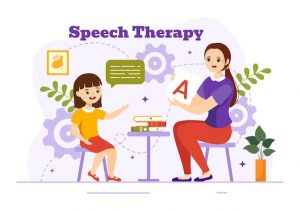Aphasia vs. Dysarthria: Breaking Down the Differences
By Rajini D
Last Updated: May 24, 2024
Have you ever had a conversation with someone and found yourself struggling to find the right words? Imagine if that happened all the time or if you knew exactly what you wanted to say but couldn’t make the sounds come out right. This is what people with communication disorders like aphasia or dysarthria experience. Communication is something we often take for granted, but when it’s affected, it can be incredibly frustrating and isolating.
Understanding Aphasia
What is Aphasia?
Aphasia is a type of language disorder that impacts an individual’s ability to communicate effectively. It can affect speaking, understanding speech, reading, or writing. For those with aphasia, it’s as if the words they want to say or understand are locked away in their minds, and they can’t quite reach them. This condition occurs when there’s damage to parts of the brain responsible for language.
Causes of Aphasia
The most common cause of aphasia is a stroke, which happens when blood flow to a part of the brain is interrupted, leading to brain cell death. However, other conditions can also cause aphasia, such as traumatic brain injuries, brain tumors, infections, and degenerative diseases like Alzheimer’s disease.
Symptoms and Types of Aphasia
Aphasia manifests in various ways, depending on the part of the brain that’s affected. There are several types of aphasia, including:
Wernicke’s Aphasia
- Also known as fluent aphasia, this type results from damage to the side portion of the left hemisphere. People with Wernicke’s aphasia can speak fluently but often produce sentences that don’t make sense. They may also have trouble understanding what others are saying.
Broca’s Aphasia
- Also known as non-fluent aphasia, this type arises from damage to the front portion of the left hemisphere. Individuals with Broca’s aphasia can understand speech but have difficulty speaking, often struggling to find the right words.
Global Aphasia
- This is the most severe form, where damage affects large areas of the left hemisphere. Individuals with global aphasia have difficulty both in understanding speech and in speaking, often accompanied by other issues like paralysis or vision problems.
Diagnosis and Treatment of Aphasia
Aphasia is typically diagnosed through a series of medical tests, including blood tests, brain imaging like CT scans or MRIs, and assessments of nerve function, hearing, and vision. Additionally, a speech-language pathologist evaluates the person’s communication skills.
Treatment for aphasia varies depending on the severity and cause of the condition. Speech therapy is a key component of treatment, where individuals work with therapists to regain their communication skills and learn new ways to express themselves. In some cases, medications or even surgery may be recommended.
Common Causes of Aphasia and Dysarthria
| Condition | Common Causes |
|---|---|
| Aphasia | – Stroke: The most common cause when blood flow to a part of the brain is interrupted.- Brain Injury: Resulting from trauma that damages language-related areas. – Brain Tumors: Growths that impact brain function. – Alzheimer’s Disease: A progressive neurological disorder affecting memory and communication. – Infections: Brain infections like encephalitis can damage language areas. – Epilepsy: Seizures affecting the brain’s language centers. |
| Dysarthria | – Stroke: Affecting brain regions controlling speech muscles. – Parkinson’s Disease: A degenerative disorder impacting movement and muscle control. – Amyotrophic Lateral Sclerosis (ALS): A progressive neurological disease affecting muscle control. – Multiple Sclerosis: A disease causing nerve damage that affects communication. – Muscular Dystrophy: A group of genetic disorders weakening muscles. – Cerebral Palsy: A condition affecting muscle tone and coordination. |
Also read: Decoding the Differences: Aphasia and Apraxia Unveiled
Understanding Dysarthria
What is Dysarthria?
Dysarthria is a type of motor speech disorder, meaning it affects the muscles used for speaking. When someone has dysarthria, their speech might become slurred or mumbled, and they may have difficulty controlling the pitch, volume, or rhythm of their voice. This condition occurs due to damage in the parts of the brain that control these muscles.
Causes of Dysarthria
Dysarthria can result from various neurological conditions or injuries that impact muscle control, such as:
- Stroke
- Brain injury
- Parkinson’s disease
- Multiple sclerosis
- Amyotrophic lateral sclerosis (ALS)
Know more: Top 10 Speech Improving Exercises for Kids with Dysarthria
Symptoms and Types of Dysarthria
The symptoms of dysarthria vary based on the type of disorder, which depends on the location of the brain damage.
Flaccid Dysarthria
- This type is caused by damage to the lower motor neurons, leading to weak or floppy muscles. Speech is often soft, slow, and slurred. It may also include breathy sounds due to air escaping while speaking.
Spastic Dysarthria
- Here, the muscles are tight and stiff, which makes speech sound harsh or strained. This type of dysarthria occurs due to damage to the upper motor neurons.
Ataxic Dysarthria
- This type results from damage to the cerebellum, the part of the brain that controls coordination. Speech may sound uncoordinated, shaky, and slow.
Diagnosis and Treatment of Dysarthria
Dysarthria is typically diagnosed through a clinical evaluation by a speech-language pathologist. The evaluation includes a medical history, observation of speech patterns, and tests of oral muscle function.
Treatment for dysarthria involves speech therapy focused on improving muscle strength, coordination, and breath control. Therapists may also recommend using communication aids like picture boards or specialized software.
Aphasia vs. Dysarthria
Key Differences
Now that we’ve explored aphasia and dysarthria separately, it’s important to highlight their key differences. Both conditions affect communication, but they do so in different ways:
- Type of Disorder:
- Aphasia is a language disorder, meaning it affects the ability to understand or produce language.
- Dysarthria is a motor speech disorder impacting the physical production of speech.
- Causes:
- Aphasia results from damage to the language centers of the brain, often due to stroke or injury.
- Dysarthria is caused by damage to the motor control regions, commonly from neurological conditions.
- Symptoms:
- Aphasia impacts the ability to understand others or to express thoughts clearly.
- Dysarthria affects muscle control for speech, leading to slurred or mumbled speech.
- Treatment:
- Aphasia treatment focuses on restoring language skills.
- Dysarthria treatment focuses on improving muscle coordination and control.
Similarities and Overlapping Conditions
While aphasia and dysarthria are distinct conditions, they can sometimes occur together. This happens when the damage to the brain affects both the language centers and the motor control regions.
- Mixed Conditions:
- When both conditions are present, it’s called mixed receptive-expressive language disorder.
- In these cases, individuals struggle with both understanding and producing speech.
- Common Causes:
- Both conditions can result from similar causes, such as a severe stroke or traumatic brain injury.
- Impact on Communication:
- Both conditions make communication challenging, impacting personal and social relationships.
- However, with appropriate therapy, individuals can improve their communication skills.
In some cases, conditions like apraxia may overlap with either aphasia or dysarthria. Learn more about apraxia here.
Seeking Help and Support
If you or someone you know is experiencing symptoms of aphasia or dysarthria, it’s important to seek professional help. Communication disorders can be challenging to manage, but with the right support, significant improvements can be made.
At Wellness Hub, we understand communication disorders’ impact on daily life. Our experienced team provides personalized support for conditions like aphasia and dysarthria, helping individuals regain their ability to communicate effectively.
Through tailored speech therapy and other interventions, Wellness Hub offers a range of services designed to meet each person’s unique needs. If you’re seeking help or want to learn more about communication disorders, explore our speech therapy services or browse through our informative blogs.
Conclusion
In this article, we looked at the key differences and similarities between aphasia and dysarthria. Aphasia affects a person’s ability to understand or produce language, while dysarthria affects their ability to produce speech physically. Both conditions can make communication difficult, but with the right diagnosis and treatment, many people can improve.
If you or someone you know has symptoms of aphasia or dysarthria, getting professional help is important. At Wellness Hub, our team provides personalized support to help people improve their communication skills. Through speech therapy and other treatments, we offer a supportive environment where people can work on their communication. While these conditions can be challenging, with the right help, there’s hope for improvement and a better quality of life. If you want to learn more, explore our speech therapy services at Wellness Hub.
Frequently Asked Questions:
1. What is the main difference between aphasia and dysarthria?
The main difference is that aphasia is a language disorder affecting comprehension and production of language, while dysarthria is a motor speech disorder that affects the physical ability to speak clearly.
2. What are the common causes of aphasia?
The most common cause of aphasia is a stroke, which disrupts blood flow to the brain. Other causes include traumatic brain injuries, brain tumors, and degenerative diseases.
3. What are the symptoms of dysarthria?
Dysarthria symptoms include slurred or mumbled speech, difficulty controlling pitch, volume, or rhythm, and weak or uncoordinated speech muscles. The symptoms vary based on the type of dysarthria.
4. How is aphasia diagnosed and treated?
Aphasia is diagnosed through medical tests and evaluations by a speech-language pathologist. Treatment often involves speech therapy to help regain language skills and learn new ways to communicate.
5. Can aphasia and dysarthria occur together?
Yes, both conditions can coexist in cases of extensive brain damage. When this happens, individuals struggle with both understanding language and producing speech, leading to a mixed receptive-expressive language disorder.
6. What are the treatment options for dysarthria?
Treatment for dysarthria includes speech therapy focused on improving muscle strength and control. Communication aids like picture boards or specialized software may also be used.
7. How can Wellness Hub help with aphasia or dysarthria?
Wellness Hub offers personalized support for communication disorders through tailored speech therapy and other interventions. Our experienced team helps individuals improve their communication and quality of life.
8. What improvements can be expected from speech therapy for aphasia?
With consistent speech therapy, individuals with aphasia can often see improvements in their ability to understand language and communicate effectively. Progress varies depending on the severity and type of aphasia.
9. What types of dysarthria can affect speech?
Dysarthria can be classified into several types, including flaccid, spastic, ataxic, hypokinetic, hyperkinetic, and mixed dysarthria, each affecting speech in unique ways due to different underlying causes.
10. Is recovery from aphasia or dysarthria possible?
Recovery from aphasia or dysarthria varies widely. Some individuals may regain much of their communication ability, especially with early and intensive intervention, while others may experience more persistent challenges.
About the Author:
Rajini Darugupally
M.Sc., Speech-Language Pathologist (9+ years of experience)
Rajini is a passionate and dedicated Speech-Language Pathologist with over 9+ years of experience, specializing in both developmental speech and language disorders in children and rehabilitation in adults. Driven by a desire to empower each individual to find their voice, Rajini brings a wealth of experience and a warm, genuine approach to therapy.
Currently, at Wellness Hub, she thrives in a team environment that values innovation, compassion, and achieving results for their clients.
Connect with Rajini to learn more about how she can help you or your loved one find their voice.
Book your Free Consultation Today
Parent/Caregiver Info:
Client’s Details:
* Error Message








